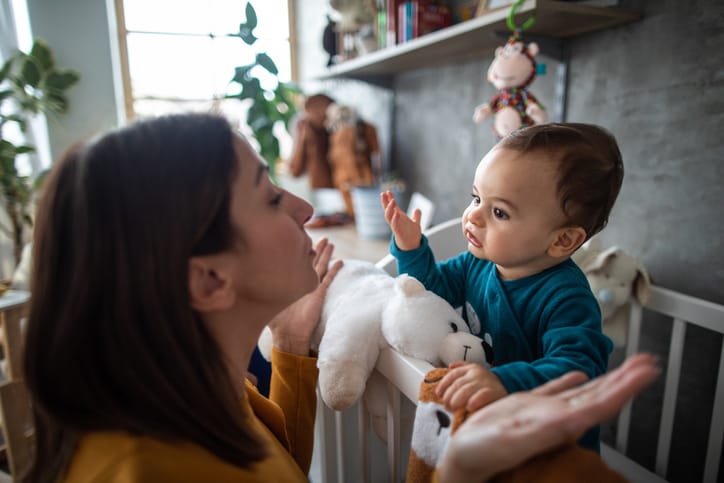When it comes to working with young children, nothing can replace hands-on experience. But in addition to knowledge gained on the job, knowledge about early child development research can help babysitters and nannies provide even better developmental support to the children they care for.
Don’t have time for a child development class right now? No worries — this cheat sheet will give you a basic rundown of early child development principles and how to apply them while babysitting or nannying.
Developmental domains and the “whole child” approach
There are four domains of early childhood development:
- Physical.
- Cognitive.
- Social-emotional.
- Language.
Not everything fits neatly into these domains, but they are used to categorize different areas within a child’s long-term development. Before diving into each domain, it’s good to understand the larger approach child development experts typically use.
“In child development, we are learning more about the interrelated nature of physical, social, emotional and cognitive growth — a ‘whole child’ view,” says Kelly Campbell, a child development professor and researcher at the University of California, Berkeley. “Think about the physical act of crawling or walking, which allows a child to explore and expand their social interactions. Then, with increasing language, their world opens up even more, helping them make friends at the playground or in the classroom.”
When babysitting or nannying, it’s important to remember all of the developmental domains and how they interact with each other. For example, is the 2-year-old you nanny suddenly throwing more tantrums than usual? It might not just be a social-emotional issue.
Instead, also consider:
- Do they have the language to express what they want?
- Do they want to climb something without help but are frustrated that they are not physically capable yet?
It’s much easier to address an issue when you are able to understand where the behavior is stemming from.
1. Physical development
The most easily observable domain of development is physical development. Margaret Bridges, director of the Early Development and Learning Science program at UC Berkeley’s Institute of Human Development, describes physical development as “how a child’s body — including the brain, bones, muscles and senses and the skills and coordination among them — grows and changes over time.”
Motor skills
Physical development includes milestones like a newborn holding their head up on their own or a toddler learning to crawl, stand, walk and eventually run. This domain also includes two kinds of motor skills.
Gross motor skills
Gross motor skills are those larger physical movements, like walking or running. It’s important to get outside as much as possible with the kids you nanny or babysit to encourage their gross motor development.
Fine motor skills
Fine motor skills are smaller, more coordinated movements, usually involving the hands and fingers. For example, learning how to use a fork or zip up a jacket are fine motor skills. When babysitting or nannying, be realistic about what the children are capable of, but be sure to give them lots of opportunities to work on fine motor skills. That could look like setting up sensory activities like a sand table, or it could look like letting them try to unwrap their own granola bar instead of always doing it for them.
Sleep
Sometimes as adults, we underestimate the power of sleep, but so much physical growth occurs during sleep, especially in early childhood. Taking naptime and bedtime seriously will not only help avoid emotional meltdowns but will support the child’s physical development as well.
2. Cognitive development
Cognitive development is the domain commonly associated with learning and school, but learning is so much more than what happens in the classroom. In fact, children begin learning about the world around them before they are even born.
“Cognitive development refers to regular changes in how we think, reason and understand the world,” explains Campbell. “Young children’s thinking processes develop over time, with the support of stimulating home and school settings.”
Little scientists
The younger children are, the more likely we are to assume they don’t understand what’s going on. But the reality is there is so much going on inside their brains, even in newborn babies.
“From newer studies we know that babies are like scientists — they observe, test ideas and learn from their experiences,” says Campbell, referencing research like Alison Gopnik’s “The Scientist in the Crib.”
Learning through play
Don’t underestimate the cognitive abilities of the young children in your life. Children can learn a lot through playing, so there’s no need to stress about going over the ABCs or counting to 10 perfectly. Just give kids the time and space to play and explore their environment, make observations and test out hypotheses like the little scientists they are.
3. Social-emotional development
Bridges says that social-emotional development has two aspects. “The emotional part refers to how children experience, regulate and express their feelings and emotions,” says Bridges. The social aspect comes into play when children “use those feelings and emotions to create and maintain their relationships and connections with other people,” according to Bridges.
Serve and return
When interacting with children, think of it like a game of tennis. The child will “serve” to you by saying or doing something to get your attention. It’s important to their development that you “return” their serve by responding. According to Harvard University’s Center on the Developing Child, when children consistently don’t get responses, they might feel emotionally neglected. This could lead to higher stress levels and more challenging behaviors as a way of getting the attention they need, or it could lead the child to become withdrawn and emotionally detached.
One potential disruptor of serve and return interactions, as you may have guessed, is your cell phone, so be sure to avoid your phone as much as possible while babysitting or nannying. Keep it nearby in case you need to communicate with the child’s family or in case of emergency, but don’t let it distract you from actively engaging with the children.
Consistency, consistency, consistency
One of the most important factors in a child’s overall development, especially their social-emotional development, is consistency. There’s no perfect formula for raising (or helping raise) a child, but the best thing any caregiver can do is keep it consistent. If you babysit or nanny for a family on a recurring basis, be sure to stick to the schedule as much as possible.
Being with a babysitter or nanny is already a shift in routine for children who are used to being with their primary caregivers, so some challenging behaviors or intense feelings might stem from that disruption to their regular routine. Having a consistent routine when you are with the children can help settle their anxieties because they will know what to expect whenever you are there. You can also communicate with their parents about their typical daily routines so that your routine with the children can be as consistent as possible with their typical routine.
4. Language development
The final early developmental domain is language development. Language development is more than learning how to talk — it’s also learning how to communicate. “It is the understanding and expression of language,” says Melita Huitt, an elementary school speech-language pathologist. “This includes: what words mean, how to make new words, how to combine words, memory for words and how to share thoughts, words and feelings,” she adds.
Talk to babies
Even if they haven’t begun talking yet, it’s important to talk to babies and young children so they can start to absorb the languages being spoken around them. When you’re babysitting, you can start by describing what you’re doing out loud. Or, ask them questions, even if you know they can’t respond with words yet. For example, I used to babysit an 18-month-old, and I would always ask her how her day was when I got there, even though she couldn’t respond with words. Sometimes I would say “Was it good?” and she would nod yes. Eventually, one day, I asked “how was your day?” and she shouted “Guh!” This is another type of serve-and-return interaction that’s great for overall development.
On “baby talk”
“Baby talk” has a reputation for damaging children’s language development. It’s not quite as nefarious as its critics claim, but speech experts like Huitt say it’s better for children’s language development to model proper usage of the language.
“Modeling of language can be done to support development,” says Huitt. She offers the following example: if a child says “baba,” the caregiver can expand on that language by modeling how to say “bottle” or asking a question like, “Would you like some more milk in your bottle?” This doesn’t mean you have to speak to a child in the exact tone as you would to an adult. You can use parentese instead by changing the pitch and tone of your voice while still modeling full words and sentences.
Don’t buy into the “perfect babysitter” myth
Many depictions of the “perfect babysitter” involve energetic sitters who arrive with a magic bag of prepared activities and crafts that will keep the children busy the whole time they are there. There’s nothing wrong with preparing some activities in advance, but try to sometimes follow the children’s lead and participate in their ideas as well, rather than constantly engaging them in a structured activity. The real perfect babysitter is one that prioritizes forming a warm, caring and respectful relationship with the children they take care of and supports their development along the way.





